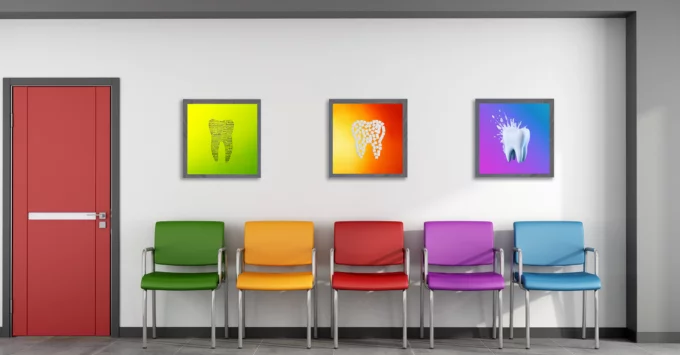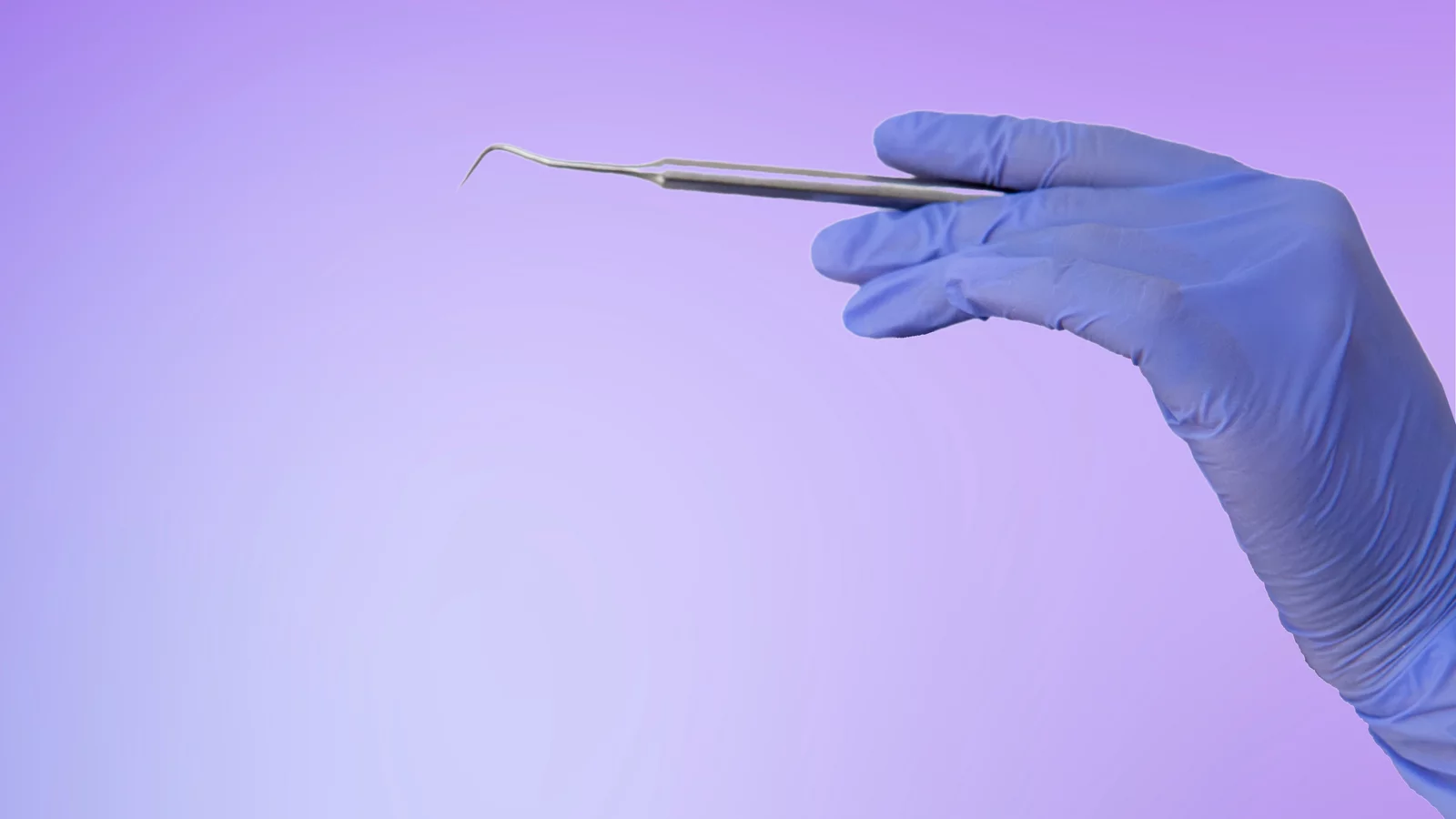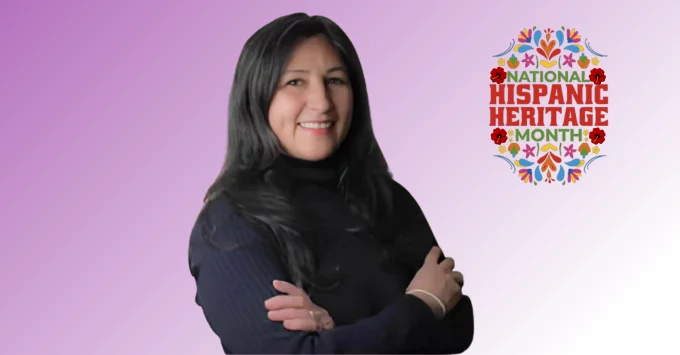By Ryan Rutar, MA, BS, BA, RDH
2022-23 Chair, ADHA Inclusion, Diversity and Equity Activities (IDEA) Committee
June 2023

Ryan Rutar, MA, BS, BA, RDH
Every June we get to celebrate and demonstrate LGBTQ+ individuals in our states and around the world. Some may wonder, why June?
WHY JUNE?
It so happens, that the tipping point of the gay liberation movement occurred on June 28, 1969, at the Stonewall Inn in New York City. This haven of comfort and safety from harassment for LGBTQ+ individuals was raided by police, using an old 19th century disorderly conduct law as justification, and patrons had had enough. It was the first time that a 6-day riot ensued for unjust treatment toward LGBTQ+ people simply for gathering and it became a catalyst for a national movement.
Thereafter, every year in June, a parade of pride and celebration was held to commemorate those who stood strong in the Stonewall Riot. It wasn’t until years later that it expanded to a month. This accommodated cities to plan celebrations at different times throughout the month, allowing people to attend more than one celebration depicting pride, self-confidence and raising the consciousness of participating LGBTQ+ individuals. One of the Pride founders, Foster Gunnison Jr., stated, “Hopefully this will develop courage, and feelings of dignity and self-worth.”
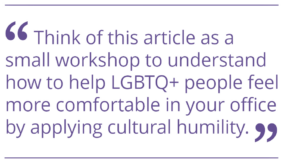 Celebrations today can include parades, picnics, concerts and even workshops or symposia that millions around the world take part in. Think of this article as a small “workshop” to understand how to help LGBTQ+ people feel more comfortable in your office by applying cultural humility.
Celebrations today can include parades, picnics, concerts and even workshops or symposia that millions around the world take part in. Think of this article as a small “workshop” to understand how to help LGBTQ+ people feel more comfortable in your office by applying cultural humility.
CULTURAL HUMILITY = OPENNESS
Cultural humility is the process of continuing to learn about a culture and being open to other people’s preferences. This approach aligns better with the health field since one can never truly be culturally competent if a culture is forever changing. It also allows one to understand one’s own personal bias that may occur toward different diversities within our population. To learn more about bias and how it can affect people around you, watch Megan Fuciarelli’s TEDx Talk on implicit bias on YouTube. Once you are able to recognize your own biases, it becomes easier to course correct when dealing with LGBTQ+ individuals. We need to remember, as dental hygienists, that we are health care providers first. We shouldn’t allow explicit bias to affect how we care for our patients, but instead we should treat them all with the desired care we would offer a friend or family member.
THE 5-STEP OFFICE CHECK ✅
Let’s start with some things you can change in your office to help LGBTQ+ people know you are queer friendly. From office décor and magazines to medical forms and stickers, there are easy ways to let LGBTQ+ patients know they are welcome and safe.
- Visible Clause. First, check your reception area. Is there a nondiscrimination clause visible for patients to see? The University of Nebraska Medical Center has a great clause that states: “Equal care will be provided to all patients, regardless of age, race ethnicity, physical ability or attributes, religion, sexual orientation, gender identity, or gender expression.” Posting such a statement allows your patients as well as your co-workers or staff to know what your expectations are for the treatment and care of your patients.
- Inclusive Visuals. Secondly, look around your office and see if you have culturally sensitive visual materials. Do you offer queer-friendly reading material and magazines, like Attitude, Out, Curve, or GQ to name a few? These magazines are not indecent and allow patients to feel comfortable and welcome in their surroundings. Look at your wall hangings. If your décor portrays people, do they represent the wide variety of patients that you see? Do you have any posters that include queer individuals in them? Lastly, do you offer brochures that depict queer people dealing with oral health issues? It’s important for enduring materials for patients to offer representation they can identify with, that explains how they can improve their oral health.
- Friendly Forms. Thirdly, be sure to have inclusive language on your medical forms. This may be in the form of questions that ask about gender, like what was their sex at birth, do they identify as transgender and what are their preferred pronouns. If a patient prefers to omit
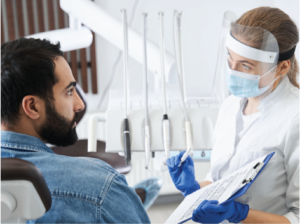 this information from their medical history form for fear of community backlash or change, the form can simply ask for a “preferred name.” All medical forms request a first, middle and last name. That, however, can be followed by an ask for preferred name. This is excellent for people who go by a nickname or shortened name like Dan for Daniel or Josey for Josephine. But it also works well for transgender individuals to communicate a change in themselves without feeling compelled to verbalize it if they’re not comfortable. This detail on the medical form helps to inform you, if for example their name was Michael but they prefer Michelle, you likely have a patient who is on the queer spectrum. A great follow up question to ask, when the individual is in your operatory room is, “I see you indicated Michelle as your preferred name on the form. Do you have a preferred pronoun?” This way you keep the conversation private between you and the patient and can enter the information in the computer medical records for other professionals in your practice to know.
this information from their medical history form for fear of community backlash or change, the form can simply ask for a “preferred name.” All medical forms request a first, middle and last name. That, however, can be followed by an ask for preferred name. This is excellent for people who go by a nickname or shortened name like Dan for Daniel or Josey for Josephine. But it also works well for transgender individuals to communicate a change in themselves without feeling compelled to verbalize it if they’re not comfortable. This detail on the medical form helps to inform you, if for example their name was Michael but they prefer Michelle, you likely have a patient who is on the queer spectrum. A great follow up question to ask, when the individual is in your operatory room is, “I see you indicated Michelle as your preferred name on the form. Do you have a preferred pronoun?” This way you keep the conversation private between you and the patient and can enter the information in the computer medical records for other professionals in your practice to know. - Safe Space Gesture. Fourth, make a gesture of a safe space in your operatory room. This could be something small like the Humans Rights Campaign sticker of an equal sign, showing them, you value equal care under the law. You could also choose to be bold and display a pride flag, a poster of your support, or wear a queer bracelet letting them know you are someone they can trust. Placing small indicators around your op allows queer people to feel safe and to open up to their medical providers. I display an equal sign sticker in my corner window. I live in a conservative state, so it’s not so bold a statement that it raises questions, but it does allow those who see it and know its meaning to feel comfortable in that space.
- Provider Directories. Finally, you can add yourself as a provider on your local LGBTQ+ medical directory or queer chamber of commerce. Find local affiliates on the National LGBT Chamber of Commerce (NGLCC) website. Being listed lets queer people know that you are LGBTQ+ friendly and you are willing and ready to help them. If your community does not offer such a resource, you can also include a statement on your own website in your “About” page. That’s also a great place to include your nondiscrimination clause that you’re posting in the waiting room.
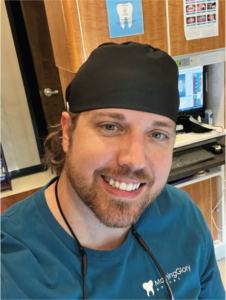 My hope in writing this brief article is to offer a little insight about my community and how you can be an ally through kind, small gestures, to encourage and assist LGBTQ+ people to receive great oral health care. A lot of LGBTQ+ individuals choose not to seek help or care for fear of stigmatization or discrimination towards them and their health. Limitations and biases are easily formed in our minds. But when we learn to apply cultural humility, step beyond our comfort zone, and choose to see beyond our biases, our possibilities to help others become endless. You can do it! Make the change you want to see in your office!
My hope in writing this brief article is to offer a little insight about my community and how you can be an ally through kind, small gestures, to encourage and assist LGBTQ+ people to receive great oral health care. A lot of LGBTQ+ individuals choose not to seek help or care for fear of stigmatization or discrimination towards them and their health. Limitations and biases are easily formed in our minds. But when we learn to apply cultural humility, step beyond our comfort zone, and choose to see beyond our biases, our possibilities to help others become endless. You can do it! Make the change you want to see in your office!
____________________________________
1) Library of Congress. History of Pride: How Activists Fought to Create LGBTQ+ Pride. Available at: https://www.loc.gov/ghe/cascade/index.html?appid=90dcc35abb714a24914c68c9654adb67. Accessed June 04, 2023
2) Fenway Healthy: Client Registration Form. Available at: https://fenwayhealth.org/wp-content/uploads/English-New-Client-Registration-Form-Update-May-2021.pdf. Accessed June 10, 2023
3) Library of Congress. Pride Month: About. Available at: https://www.loc.gov/lgbt-pride-month/about/. Accessed May 24, 2023
4) Stubbe DE, Practice Cultural Competence and Cultural Humility in the Care of Diverse Patients. Journal of Life Long Learning in Psychology. Available at: https://focus.psychiatryonline.org/doi/10.1176/appi.focus.20190041
_______________________________________
Ryan Rutar, MA, BS, BA, RDH, is president and cofounder of Pearly White Prevention and consults in dental offices to improve dentist/hygienist relationships, and coaches hygienists who want to change the way they deliver care. He has a dual role at Morning Glory Dental private practice as a clinical hygienist and dental hygiene manager. Ryan is a frequent contributor and international presenter as well as a long-time, active member of the ADHA. He was the 2022-23 Chair of the ADHA’s Inclusion, Diversity and Equity Activities (IDEA) Committee and also served on the ADHA Leadership Development Committee. He can be reached at pearlywhiteprevention.com.
